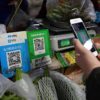For those unfamiliar with the replicator in Star Trek, it is a futuristic device that can produce any type of food or drink based on a voice command (such as when Patrick Stewart’s Jean Luc Picard says “Tea. Earl Grey, Hot,” at regular intervals during Star Trek: The Next Generation.”) The devices can can reconstitute matter and produce everything that is needed out of pure energy. Not only is the replicator efficient, in the communistic society envisaged in the Star Trek universe, no money exists and the replicator is available to everyone.
For our current time, NASA is focused on the first deep space mission (which will probably be to Mars), and with how astronauts will support themselves. Studies have been taking place with growing plants in micro-gravity environments, but copious green matter may prove insufficient for the intrepid ‘Dan Dares‘ to support themselves.
The idea of replicators is not totally embedded in the sci-fi genera. Researchers at Nestlé, for example, have been developing technology comparable to the replicator. Here the idea is to produce food tailored to an individual’s nutritional requirements. Others are looking at types of 3D printing. Currently 3D printers can only work with materials like plastics, metals, and clays. However, it is not technically impossible, provided there are the right inputs, to print food.
This is where the new NASA challenge comes in. Young scientists have been set the challenge of engineering the future of food production through processes analogous to 3D printing. The contest was sponsored by the American Society of Mechanical Engineers.
One contest winner, Gizmag reports, was Kyle Corrette (of Desert Vista High School in Phoenix, Arizona.) The student has outlined designs for a “Melanized Fungarium“, which is a type of semi-automated mushroom farm. Ionizing radiation in space could be harnessed to help fungi to grow.
A second idea is a Astro Mini Farm. This is a Martian greenhouse designed which could provide fresh produce for astronauts on a mission to the red planet. A third concept is a Spirulina Farm that grows fresh algae under LED lights. Reactions to the prize winners are trending high on Twitter.
These ideas are all interesting and they could potentially aid astronauts in the planned deep space missions (which won’t begin until around 2050.) They are, in their own ways, inspired by Star Trek and its universal replicator idea.













